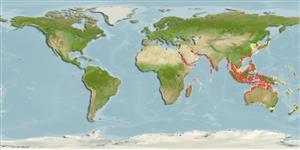Klassifizierung / Names
Namen | Synonyme | Catalog of Fishes (gen., sp.) | ITIS | CoL | WoRMS | Cloffa
Actinopterygii (Strahlenflosser) >
Perciformes (Perch-likes) >
Carangidae (Jacks and pompanos) > Caranginae
Etymology: Atropus: The name of the Parcae, fates of Roman mythology (Ref. 45335).
Lebensraum / Klimazone / Range
Ökologie
; seewasser; amphidrom (Ref. 51243). Tropical, preferred ?
Indo-West Pacific: in the tropical waters, north to Mie Prefecture, Japan.
Length at first maturity / Size / Gewicht / Alter
Maturity: Lm 21.0 range ? - ? cm
Max length : 26.5 cm TL Männchen/unbestimmt; (Ref. 9894)
Rückenflossenstacheln (insgesamt): 9; Rückenflossenweichstrahlen (insgesamt): 21-22; Afterflossenstacheln 3; Afterflossenweichstrahlen: 17 - 18. This species is easily recognized by its long pelvic fin which fit into a groove along the midline of the belly when depressed. Scutes are present along its straight lateral line. Adult males have prolonged middle rays in the soft dorsal and anal fins. This species attains 25 cm in SL.
Adults are common in shallow coastal waters where they often swim near the surface. They feed mainly on shrimps, copepods, decapod crustaceans and small fish.
Life cycle and mating behavior
Geschlechtsreife | Fortpflanzung | Ablaichen | Eier | Fecundity | Larven
Masuda, H., K. Amaoka, C. Araga, T. Uyeno and T. Yoshino, 1984. The fishes of the Japanese Archipelago. Vol. 1. Tokai University Press, Tokyo, Japan. 437 p. (text). (Ref. 559)
IUCN Rote Liste Status (Ref. 115185)
CITES (Ref. 94142)
Not Evaluated
Bedrohung für Menschen
Harmless
Nutzung durch Menschen
Fischereien: weniger kommerziell
Tools
Zusatzinformationen
Download XML
Internet Quellen
